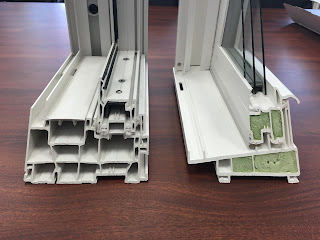The cause of problem condensation in your home is excess humidity. Increased use of moisture trapping materials in the last few years has created the modern "tight" home. Moisture created by kitchens, bathrooms, laundries and occupants no longer flows easily to the outside as it used to in older homes. Replacing new, energy-efficient windows is an example of creating a "tight" home. Your older windows used to allow the transfer of humidity, since they were not "tight".
If you find excess condensation on your new, energy-efficient windows, it means that the humidity in your home is too high. Reducing the humidity will reduce or eliminate the condensation.
The University of Minnesota Engineering laboratories have created a table showing the maximum safe humidity levels for your home. Below are those guidelines:
These relative humidity levels are for a 70℉ home. For higher temperatures, lower humidity levels are required.
If you have any questions, feel free to post a comment on the blog. Or you can reach out to me via Windows Plus in Cincinnati and in Dayton, Ohio.
Thanks for reading!






